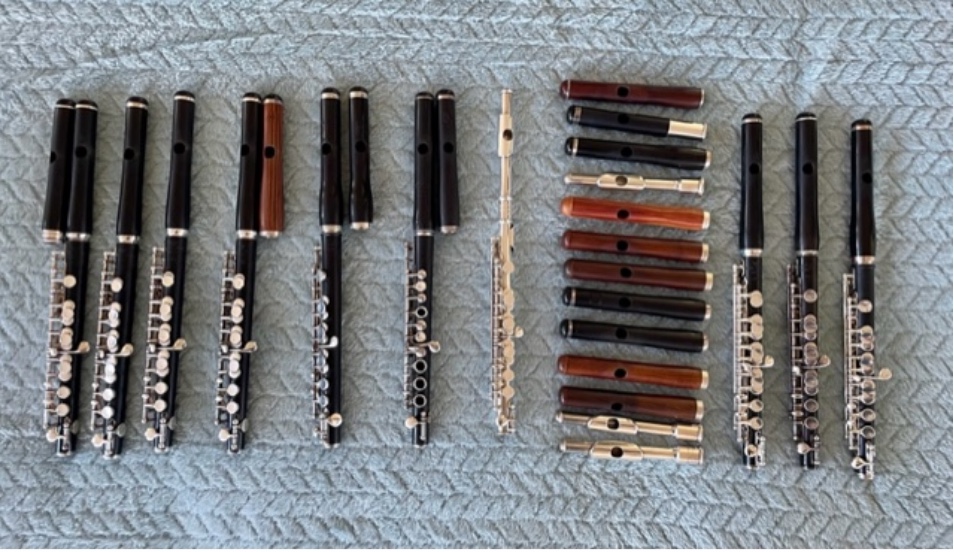by Mike Telin

Once Fink and Zehavi decided that a new concerto was something they wanted to pursue — and with The Cleveland Orchestra onboard for commissioning the piece — the creative process began. Everything went as planned, and the world premiere was set for April of 2020 — only to have it canceled due to COVID.
After a four-year wait, Mary Kay Fink will give the world premiere of Oded Zehavi’s Aurora with The Cleveland Orchestra on Thursday, March 7 at 7:30 pm at Severance Music Center. Under the direction of Fabio Luisi, the 7:30 pm concert will also include Weber’s Overture to Oberon and Brahms’ Symphony No. 4. The program will be repeated on Friday at 7:30 pm and Saturday at 8:00 pm. Tickets are available online.
Fink said that when she found out a new date had been set for the premiere, she was happy to discover that the piece was still mostly embedded in her brain. “It was nice to have let it percolate, but there was some unfamiliarity when it came to relearning the technical parts. And of course I’m four years older now.”
How has the piece, and her approach to it, evolved during the hiatus? “I think the tempos are more settled to where the piece actually works better. It also has more of an arc — building with intensity and energy — before it calms down at the end. And I can play some passages faster than I did four years ago. So I think we found the right tempi.”
Although the composer sent Fink a MIDI version of the orchestral part which gave her a sense of the harmony and colors, she is looking forward to hearing it with the orchestra. “It has a unique flavor and I cannot think of any solo piccolo piece that is anything like it. And that’s wonderful, because we need more great music in the piccolo literature.”
Another plus is that throughout the concerto’s seventeen minutes, Zehavi resisted including any musical clichés that are often associated with the instrument. “There are no bird calls and no marches — nothing cutesy.”
Fink said that she is happy to be premiering Aurora with Fabio Luisi on the podium. “He’s an excellent musician and wonderful conductor — it’s going to be a great experience.”
What make of piccolo will she be using? “I have quite a collection of instruments, but I’m going with my very favorite setup — it’s a Powell made in I think 1949. And I use a head joint from a different old Powell that’s probably from the ‘50s. Generally speaking I just prefer the sound of the older instruments compared to the newer ones. There is something about the wood aging too, which is probably also a factor.”
Verne Q. Powell Flutes Inc. has been a producer of professional flutes and piccolos in Boston since 1927. “They’re still in business. Back when my piccolos were made there was just one man and a very small shop, and everything was made from beginning to end by Verne Q. Powell, the man himself.”
How many piccolos does Fink have? “Oh my gosh — I probably have about ten and quite a few extra head joints. I know, it’s ridiculous.” She admitted to having a reputation for being a collector of older instruments, including one by French maker Auguste Bonneville from the late 1800s. (6th from left) “It’s a very cool instrument — it has ring keys, so it’s similar to an open holed flute that most of us use today. Robert Dick [the renowned flutist, composer, teacher, and author] wrote a piece for it that makes use of the ring keys — my fingers can slide off and on the holes — something you can’t do with regular keys.”
When a piccolo crosses her path, Fink said that she can usually tell by playing it and by its serial numbers whether or not it’s going to be a good instrument. “If it is, even if it’s in disrepair, I’ll have it overhauled and either keep it or find a home for it. One of my friends called it my piccolo orphanage. But it is nice to have an extra piccolo or two just in case a student comes along who doesn’t have one.”
Published on ClevelandClassical.com March 4, 2024.
Click here for a printable copy of this article




